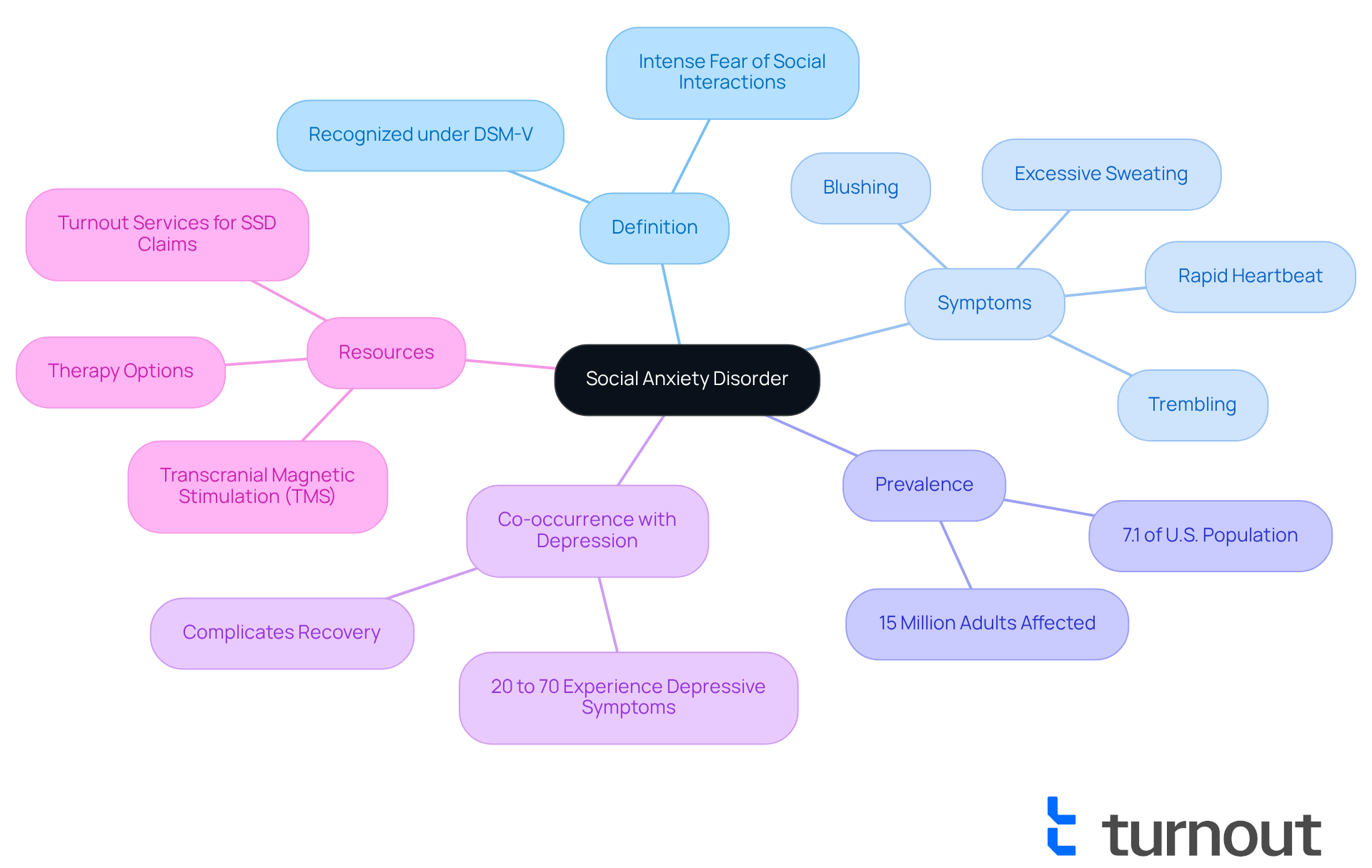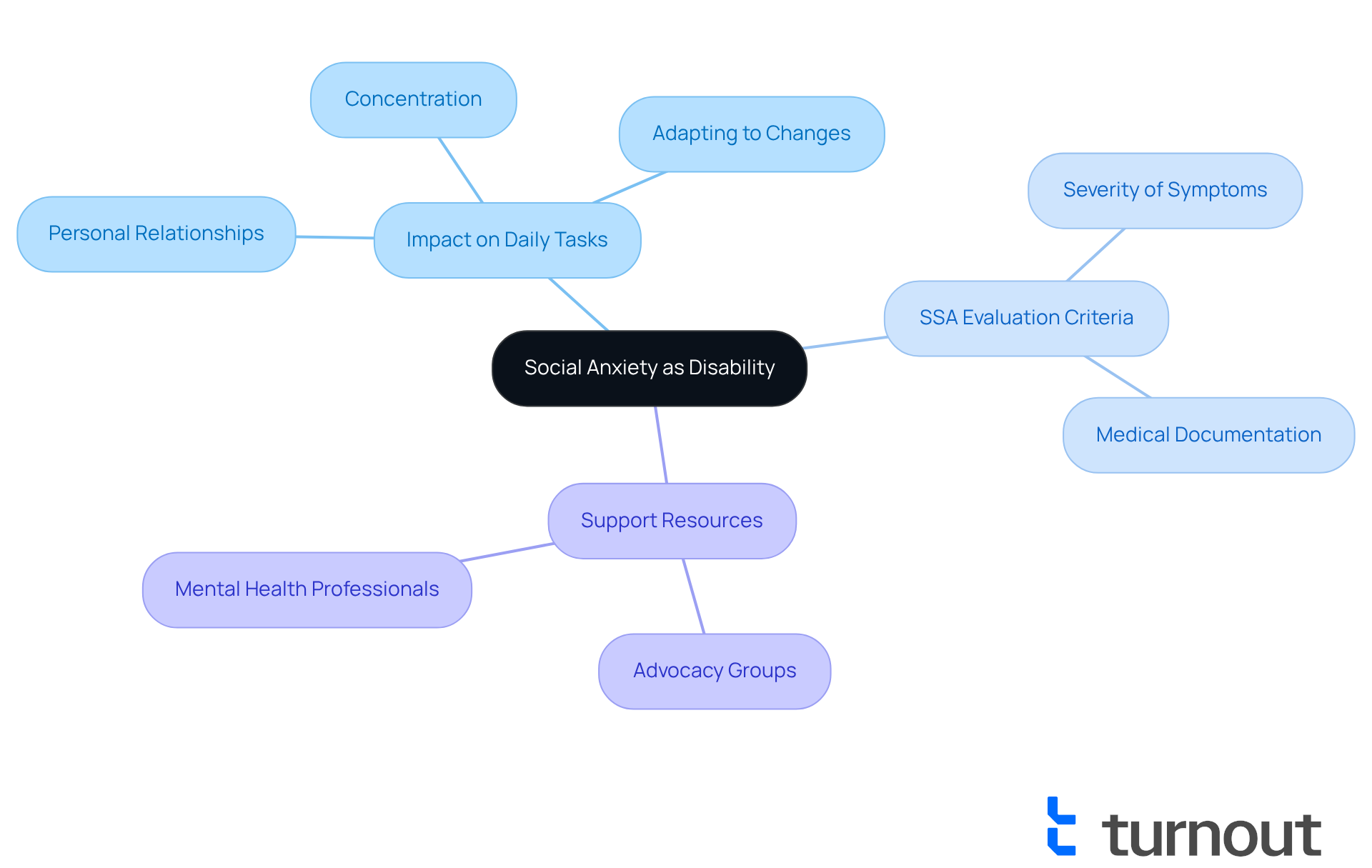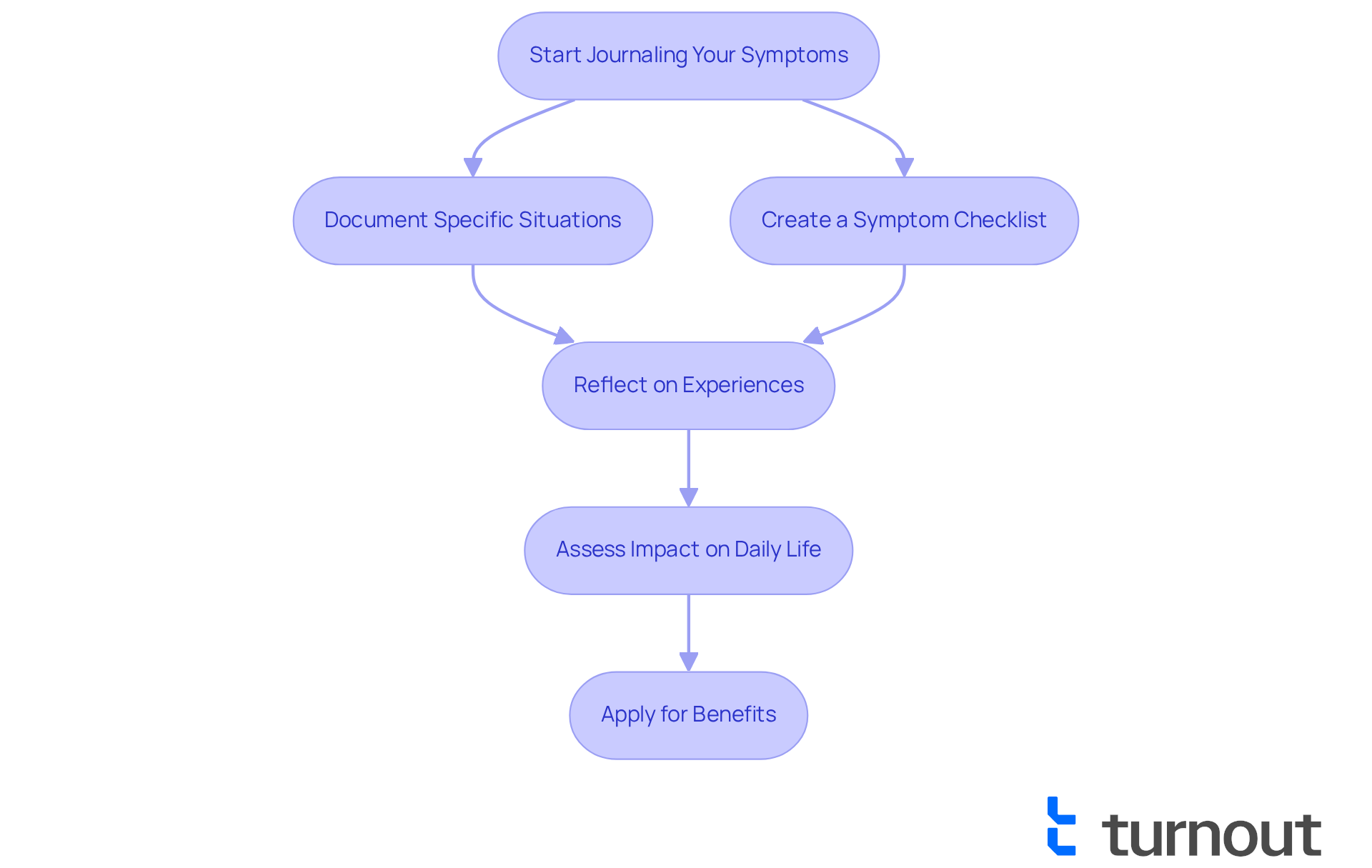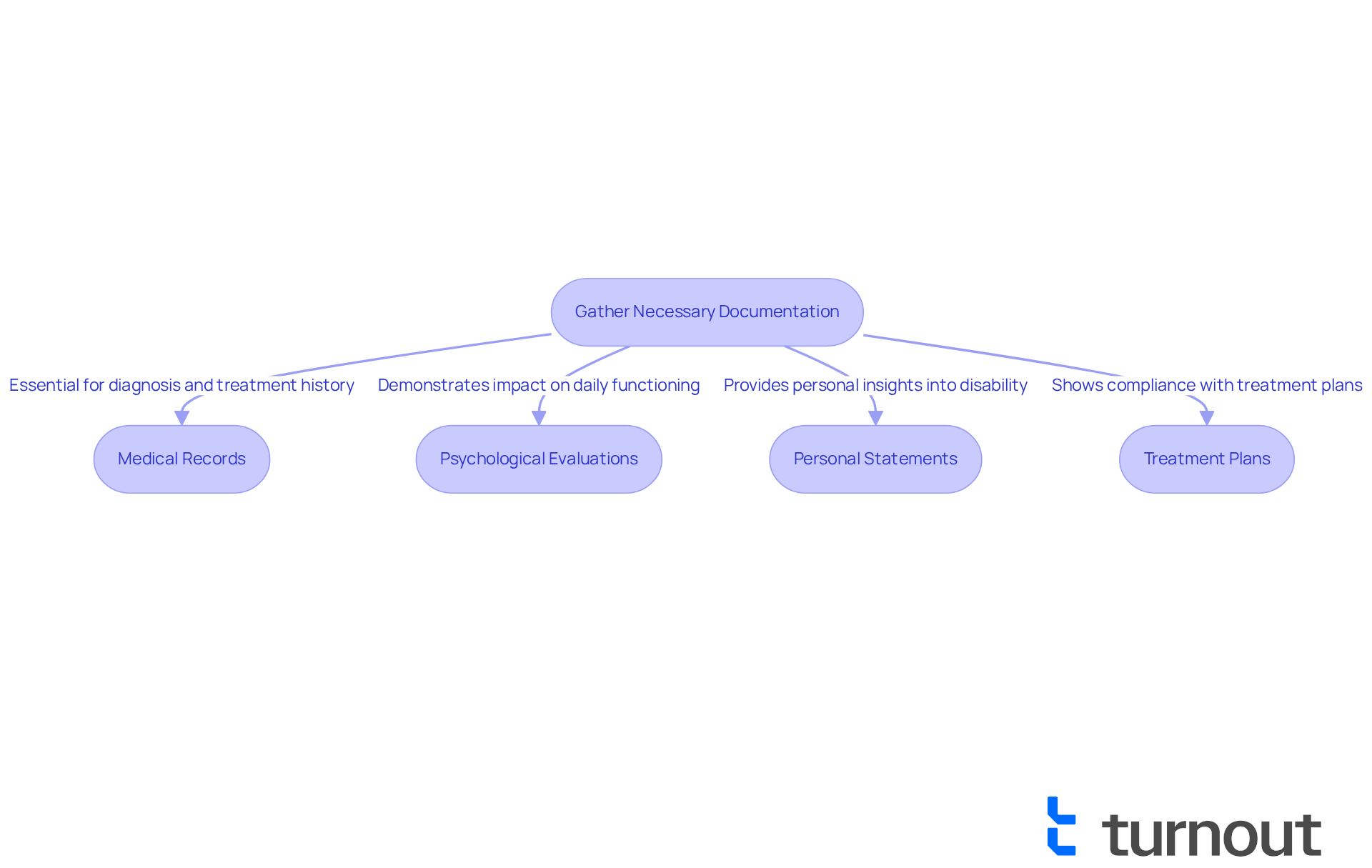Overview
Social anxiety can indeed be considered a disability, and it may qualify individuals for disability benefits. If you find that social anxiety significantly impairs your daily functioning and ability to work, there is hope. To successfully claim these benefits, it's essential to provide comprehensive medical documentation and personal evidence. This documentation should illustrate the profound effects of social anxiety on your life.
We understand that this process can feel overwhelming. However, it's increasingly recognized by the Social Security Administration that social anxiety is a legitimate concern. You are not alone in this journey; many individuals have navigated similar paths and found support.
Take the first step by gathering your medical records and reflecting on how social anxiety affects your everyday life. Remember, we’re here to help you through this process. Your experiences matter, and with the right support, you can advocate for the assistance you deserve.
Introduction
Social Anxiety Disorder (SAD) affects millions, creating barriers that can hinder daily functioning and diminish quality of life. We understand that navigating these challenges can feel overwhelming. As awareness grows around mental health, the question of whether social anxiety qualifies as a disability is becoming increasingly relevant for those seeking support. This article will explore the criteria for claiming disability benefits, the documentation required, and the steps you can take to navigate the application process effectively.
What challenges lie ahead for those grappling with social anxiety? It's common to feel uncertain and alone in this journey. However, we want you to know that you are not alone, and there are pathways to ensure your voice is heard in the pursuit of necessary assistance. Together, we can explore the options available to you.
Define Social Anxiety Disorder
(SAD), often referred to as social phobia, can feel overwhelming. It is characterized by an intense fear of social interactions, where individuals may fear being evaluated or scrutinized. For those affected, the symptoms can be debilitating—excessive sweating, trembling, blushing, and a rapid heartbeat are common during social engagements. The impact of SAD on daily life can be profound, influencing relationships, work performance, and overall quality of life. Did you know that around 15 million adults, or 7.1% of the U.S. population, are affected by this condition? This statistic highlights the prevalence of SAD and the .
Mental health professionals emphasize that SAD is a serious mental health disorder, recognized under the DSM-V. We understand that individuals with interpersonal concerns may also be at risk of developing depression. In fact, estimates suggest that between 20% and 70% of those diagnosed with SAD experience depressive symptoms at some point in their lives. This co-occurrence complicates recovery, underscoring the need for .
Real-world examples illustrate the challenges faced by individuals with SAD. Many people report avoiding social situations altogether, leading to isolation and hindering their ability to seek necessary support, including disability benefits. For instance, it’s not uncommon for individuals to let others call them by the wrong name out of fear of correction. This reflects the intense anxiety that permeates everyday interactions.
provides access to tools and services that assist individuals with SAD in understanding and applying for (SSD) claims, as well as . With trained nonlawyer advocates, Turnout helps clients navigate the complexities of government-related processes without needing legal representation. Recent advancements in treatment options, such as therapy and Transcranial Magnetic Stimulation (TMS), show promise for those who do not respond to traditional therapies. These advancements offer hope for enhanced management of symptoms, enabling individuals to regain their lives and navigate interpersonal situations with greater ease.
Comprehending the implications of whether social anxiety is a disability is essential for . The effects of this condition can significantly impede one’s capacity to function in everyday life. Remember, you are not alone in this journey. We're here to help you find the support you need.

Understand Disability Criteria for Social Anxiety
If you are struggling with social phobia, it’s important to know that social anxiety may be considered a disability, which may make you eligible for . To qualify, you must demonstrate how your condition significantly impacts your ability to perform daily tasks and maintain employment. The Social Security Administration (SSA) evaluates and determines if based on specific criteria, including the severity of symptoms and their effects on your interactions with others.
We understand that presenting proof of your distress is crucial. You’ll need to demonstrate that, in the context of whether social anxiety is a disability, your social anxiety leads to considerable limitations in areas such as:
- Personal relationships
- Concentration
- Adapting to changes in your routine
Recent updates reveal that nearly 20% of disability claims approved by the SSA relate to severe mental health conditions, prompting discussions about whether social anxiety is a disability. This recognition is a positive step forward.
Successful claims often include that illustrates the severity and duration of your symptoms, as well as their impact on your daily life. For example, if you can demonstrate that your in maintaining relationships or fulfilling work responsibilities, your chances of approval increase.
Turnout is here to . While we are not a law firm and do not provide legal representation, our trained can help you prepare your claims and gather the necessary documentation. It’s essential to have , who can assess your condition against the SSA's criteria outlined in the Blue Book. This includes reviewing how often you experience anxiety episodes and their effects on your everyday life.
As SSA officials have noted, the evaluation process for mental health conditions is thorough. It requires clear evidence of how your social phobia restricts your ability to function in daily activities, which leads to the question: is social anxiety a disability? However, statistics show that related to mental health are improving. This shift reflects a growing understanding of how these conditions affect everyday functioning.
If you are experiencing interpersonal discomfort, remember that you are not alone in this journey. With compelling medical evidence and the support of advocates from Turnout, many individuals are finding success in their claims. We’re here to help you navigate this process and ensure that your voice is heard.

Evaluate Your Symptoms and Daily Impact
To effectively record your experiences with , we encourage you to start a thorough journal. This journal should note your symptoms and their effects on your everyday life. Consider documenting specific situations where discomfort prevents you from engaging in activities like going to work, attending gatherings, or even completing daily tasks. A symptom checklist can be a helpful tool in assessing the frequency and severity of your distress in different situations, offering you a clearer understanding of its impact.
This documentation is crucial when , as it serves as to determine if that limits your functioning. It’s common to consider how , specifically the issue of whether social anxiety is a disability, can greatly disrupt everyday tasks, affecting family, community, and professional life. For instance, many individuals with interpersonal apprehension often experience severe fear and concern, leading to avoidance behaviors that can further isolate them.
Psychologists emphasize the importance of acknowledging these effects. Maintaining a not only aids in the but also helps you understand your condition more effectively. By reflecting on your experiences, you can articulate the , making it easier to communicate your needs during the application process. This proactive approach can ultimately strengthen your case for receiving the . Remember, you are not alone in this journey; we’re here to help.

Gather Necessary Documentation for Your Claim
To successfully support your claim for , it’s essential to gather thorough records that illustrate the . We understand that this process can feel overwhelming, but collecting the right documentation is a vital step toward receiving the help you need. Here are some key elements to consider:
- Medical Records: Obtain detailed records from your healthcare providers that outline your diagnosis, treatment history, and any prescribed medications. These documents should reflect ongoing treatment and any changes in your condition.
- : Secure assessments that evaluate the intensity of your interpersonal discomfort. These assessments are crucial in demonstrating how your condition limits your daily functioning and ability to work.
- Personal Statements: who can provide insight into that affects your daily life and interactions. Their observations can add a personal dimension to your claim.
- : Include any prescribed [treatment plans](https://blog.myturnout.com/7-essential-tips-for-navigating-tdiu-benefits-successfully), such as therapy or medication, along with records that demonstrate your compliance with these treatments. This evidence is essential in proving the validity of your assertion.
As we look ahead to 2025, the criteria for disability documentation emphasize the necessity for comprehensive and well-documented evidence. Numerous successful requests for mental health conditions, including the consideration of whether social anxiety is a disability, depend on the quality of the documentation submitted. It’s common to feel uncertain about what to include, but remember that every detail matters. As supporters often mention, "Maintaining a journal of your daily challenges with depression can offer further proof of how your condition affects your life." This proactive approach not only strengthens your argument but also highlights the real-world consequences of your situation. You are not alone in this journey; we’re here to help you navigate it.

Navigate the Application Process for Disability Benefits
Applying for can feel overwhelming, especially when questioning if social anxiety is a disability, but we're here to help you through this process. Follow these :
- Complete the Application: You can apply online through the SSA website or in person at your local SSA office. It's crucial to fill out all sections accurately, as incomplete applications can lead to frustrating delays.
- Submit Documentation: Gather and include all necessary documentation to support your claim. This may encompass medical records, treatment history, and personal statements that detail how social anxiety affects your daily life. Providing comprehensive evidence is vital.
- Follow Up: After submitting your application, keep track of its status. You may need to provide additional information or clarification, so staying proactive is essential. We understand that , but staying engaged can make a difference.
- Prepare for Appeals: If your application is denied, don't be discouraged. It's common for about 70% of initial requests for (SSDI) and Supplemental Security Income (SSI) to be rejected. However, you can contest the decision. Gather further evidence, such as updated medical documentation or testimonials, and consider seeking assistance from a to strengthen your case.
Recent updates indicate that the (SSA) is working to streamline the application process. Still, the average wait time for a decision remains around 232 days. Successful appeals for Social Anxiety Disorder claims often hinge on providing clear evidence that addresses the question of whether social anxiety is a disability and its impact on your ability to work. Understanding common application pitfalls, like failing to provide sufficient medical evidence or not detailing the functional limitations caused by your condition, can significantly improve your chances of approval. Remember, you are not alone in this journey, and there are resources available to support you.

Conclusion
Social Anxiety Disorder (SAD) can profoundly impact individuals, often leading to significant challenges in daily functioning and quality of life. We understand that recognizing SAD as a potential disability opens the door for those affected to seek the support and benefits they may need. Understanding the nuances of this condition and its implications for disability claims is crucial for anyone grappling with the debilitating effects of social anxiety.
Throughout this discussion, we highlighted key points, including:
- The definition and prevalence of social anxiety disorder
- The criteria for qualifying as a disability
- The importance of thorough documentation when applying for benefits
It's essential to demonstrate how SAD limits personal relationships, concentration, and adaptability in daily life. With the right support and preparation, you can navigate the application process effectively, increasing your chances of receiving the assistance you deserve.
Ultimately, acknowledging social anxiety as a legitimate disability is a vital step toward fostering understanding and support for those affected. By documenting your experiences and gathering necessary evidence, you can advocate for your needs and work toward reclaiming your life. Remember, help is available, and taking proactive steps can lead to improved outcomes in both personal and professional spheres. You are not alone in this journey; we’re here to help.
Frequently Asked Questions
What is Social Anxiety Disorder (SAD)?
Social Anxiety Disorder (SAD), also known as social phobia, is characterized by an intense fear of social interactions, where individuals may fear being evaluated or scrutinized. Symptoms can include excessive sweating, trembling, blushing, and a rapid heartbeat, significantly impacting daily life and relationships.
How prevalent is Social Anxiety Disorder in the U.S.?
Approximately 15 million adults, or 7.1% of the U.S. population, are affected by Social Anxiety Disorder, highlighting its prevalence and the importance of understanding this condition.
What are the potential co-occurring conditions with SAD?
Individuals with Social Anxiety Disorder may also develop depression, with estimates suggesting that between 20% and 70% of those diagnosed with SAD experience depressive symptoms at some point in their lives.
How can Social Anxiety Disorder affect daily life?
SAD can lead individuals to avoid social situations altogether, resulting in isolation and hindering their ability to seek necessary support, including disability benefits. Everyday interactions can become challenging, such as avoiding correction when called by the wrong name due to fear.
What resources are available for individuals with SAD seeking support?
Turnout provides access to tools and services that assist individuals with SAD in understanding and applying for Social Security Disability (SSD) claims, as well as tax debt relief, with trained nonlawyer advocates to navigate complex processes.
What treatment options are available for Social Anxiety Disorder?
Recent advancements in treatment options, such as therapy and Transcranial Magnetic Stimulation (TMS), show promise for individuals who do not respond to traditional therapies, offering hope for better symptom management.
Can Social Anxiety Disorder be considered a disability?
Yes, social anxiety may be considered a disability, making individuals eligible for disability benefits if they can demonstrate how the condition significantly impacts their ability to perform daily tasks and maintain employment.
What criteria does the Social Security Administration (SSA) use to evaluate social anxiety as a disability?
The SSA evaluates mental health conditions based on the severity of symptoms and their effects on personal relationships, concentration, and adapting to changes in routine.
What evidence is needed for a successful disability claim related to SAD?
Successful claims often require comprehensive medical documentation that illustrates the severity and duration of symptoms, as well as their impact on daily life, such as challenges in maintaining relationships or fulfilling work responsibilities.
How can Turnout assist individuals with Social Anxiety Disorder in the claims process?
Turnout offers support through trained nonlawyer advocates who can help prepare claims and gather necessary documentation, ensuring that individuals have detailed evaluations from qualified mental health professionals to meet SSA criteria.
What is the current trend in disability claims related to mental health conditions?
Nearly 20% of disability claims approved by the SSA relate to severe mental health conditions, and statistics show improving approval rates for claims related to mental health, reflecting a growing understanding of these conditions' impacts on daily functioning.




